2.11 Finance
2.11.1 Financial Management
Financial Management quantifies, in financial terms, the value of IT services for the business and IT department. This includes measuring the value of the underpinning infrastructure that provides the services and qualifying operational forecasts. Applying a services approach to IT, financial management helps identify, document and agree on the value of services being provisioned by IT, and provides service demand modeling and management.
With a goal to ensure funding for the delivery and consumption of services, Financial Management focuses on the demand and supply requirements based on business strategy, capacity inputs and forecasting use. As a transitional role between an organization's corporate finances and service management, Financial Management calculates and assigns a monetary value to a Service and service components to allow costs to be spread across the organization.
The monetary value is derived by calculating the operating and capital costs, which include the investments made in hardware and software license costs, annual maintenance fees for hardware and software and personnel resources used to support and maintain the services, across the number of Users.
Tightly integrated throughout the application, Financial Management derives hierarchical costs from within the CMDB and considers Org Units as Cost Centers, while extending functionality built into the Service Item costs calculator. Used as a forecasting tool, it provides the service organization with information about pricing a service, by detailing the contributing cost factors and applying concepts such as cost splitting across services that leverage common infrastructure. Stored in the CMDB, the central repository, organizations can generate their own reports and all data is broken down by cost center, ready to be reassembled in real time for the User interface to assist with business planning and the budgeting processes.
Financial Management is not a standalone process in this service management application, but a component of Service Portfolio Management and the Service Catalog, with direct access being found within the Service Item Costs tab of any Service Category Item.
To access this functionality, Users must be assigned the Finance Role, in the Information tab of their User information screen. For detailed information about using Financial Management, refer to Financial Management Applied.
2.11.2 Financial Management Applied
Financial Management can be used to forecast the costs for offering a Service and can also calculate the amount that should be charged to the Service Users in order to recover costs.
To use Financial Management as a tool for calculating the financial value of the underpinning infrastructure that provisions services and to qualify operational forecasts, you need to:
-
Provide the User access to the functionality
-
Enable SLA costing functionality
-
Enable the functionality within the Category
-
Create the Item Type and enter forecast figures
-
Create the Service Item, which automatically applies the forecast figures
-
Build the relationships between the Service and underpinning hardware and software, to associate actual costs
-
Use Finance Reports to compare forecast costs with actual costs, and chargeback costs to the Org. Unit Users.
NOTE:To complete the following outlined process, a User must have Supervisor and Administrator access.
Enable Financial Management Access
To access the Financial Management functionality a User must be assigned the Finance Role within the Information tab of their User Information screen. Assigning the Role within a system synchronized with an authentication server, the system administrator needs to include the User in the Finance group in LDAP.
To switch on the functionality for an existing User in a system not synched with an LDAP server, as a Supervisor:
-
Select the User > Users tab
-
Click on the Name hyperlink of the relevant User
-
Select Edit
-
Tick the Finance box in the Roles field

-
Click Save.
The User can now access the Finance Management functionality within the consolidated User view.
Enable Functionality
Financial information can only be calculated for Service Items that are created using a Category, which has the Service Category option enabled. By enabling this option, the Costs Tab is made available with the Item Type where baseline figures can be recorded.
As a User with the Finance Role:
-
Move to the Configuration > Categories tab
-
Click the Service Item Category hyperlink
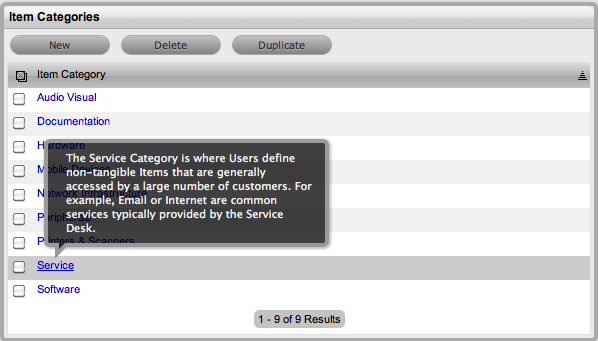
-
Verify the Service Category option is checked
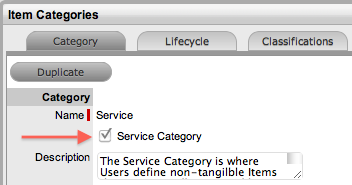
-
Click Done.
Charging for Service
If the service and support organization is to charge Organizational Units, that is companies or departments, for the ongoing service they provide the costing functionality for the Service Level Agreements (SLAs) needs to be enabled, and the Prices for the different Agreements need to be assigned to each of the SLAs.
As a User with Administrator access, within the Setup screen:
-
Select Setup > Billing
-
Click Yes for the Display SLA Prices option
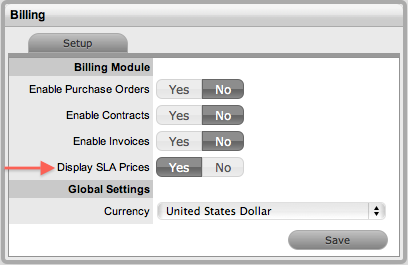
-
Click Save
The Annual, Request and Hourly Price fields are now made available within an SLA Editor screen.
-
Switch to the User Portal to access the Supervisor view
-
Move to the Service > SLAs tab
-
Select the Name hyperlink for an SLA
The SLA Editor is now displayed.
-
Click Edit
-
Enter the relevant figure in the Annual Price field
The Annual Price entered should be the per User, per year price for the SLA.
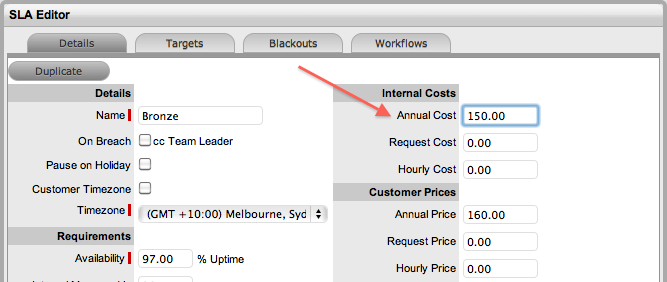
-
Click Save and Done.
Repeat the process for all relevant SLAs configured in the system. For detailed information about configuring SLAs see Creating SLAs.
Forecast Service Costs
When proposing a Service as part of Service Portfolio Management, the investment and ongoing costs for offering a Service can be calculated. This information can then be used to project potential revenue for offering the Service and allow consumers of the Service to be charged for accessing the Service based on User access. For an example, we will use the Service Desk Service, considering the investment in hardware and software plus the ongoing SLA expense for offering the Service, when forecasting costs.
To forecast the cost of offering a Service, as a Financial User:
-
Move to the Configuration > Types tab
-
Select the default Service Desk Item Type
If creating a new Item Type refer to Creating Item Types.
-
Click Edit
-
Search and select the relevant SLAs for the Supported Levels field
This is where SLAs that have Prices are associated with them.
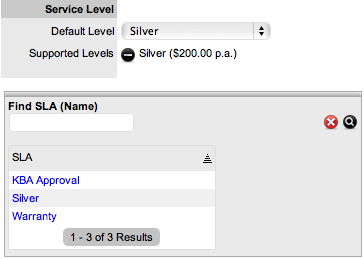
-
Move to the Costs Tab
The Capital, Recovery and Recurring cost fields are now displayed.
-
Complete the following fields:
Costs
Capital
Enter the sum total to be invested in hardware and software infrastructure that will underpin the Service.
Recovery
Complete the field with the number of years designated to recover the costs of implementing the Service.
Recurring
Enter the ongoing cost, on a per calendar month basis, for offering the Service. For example, annual support and maintenance agreement costs charged on a monthly basis.
Services
Using the details entered in the Costs fields and the cost per annum of the SLA, enter the forecast number of Customers/Users to calculate the break even point (B.E.P) of the Service. Using the auto-calculated B.E.P., enter a per calendar month Price for the Service to recover costs. This figure is used in the Service Item Costs tab to calculate the ongoing Revenue figures.
NOTE:If an SLA with an Internal Cost is assigned to the Type, the B.E.P will be the SLA cost divided by 12 plus the cost of recovering the Capital expenditure over the number of years defined for the Capital to be recovered. For example, where the SLA cost is $240 for the year, the B.E.P will never be less than $20 per month.
Actual Costs
Capital
Content for this field is derived from the Cost field within the Costs tab of the Item created using this Type.
Recurring
Content for this field is derived from the Monthly Cost field within the Costs tab of the Item created using this Type.
-
Enter a figure in the Forecast Users field for each SLA
(The displayed SLAs are based on the ones assigned to the Supported Levels field in the Information tab.)
If multiple SLAs are assigned to the Item Type and Forecast Users are assigned to each SLA, the Costs are divided by the total number of Forecast Users as calculated across the SLAs to arrive at the B.E.P. The system does not differentiate between who the Users are, it only accounts for the number of Users
-
Enter the Price for the Service to recover costs in a per calendar month
Use the calculated Break Even Point (B.E.P.) to set the Price. This figure is then used as a comparison figure for the Actual cost in the Service Item Costs Tab.
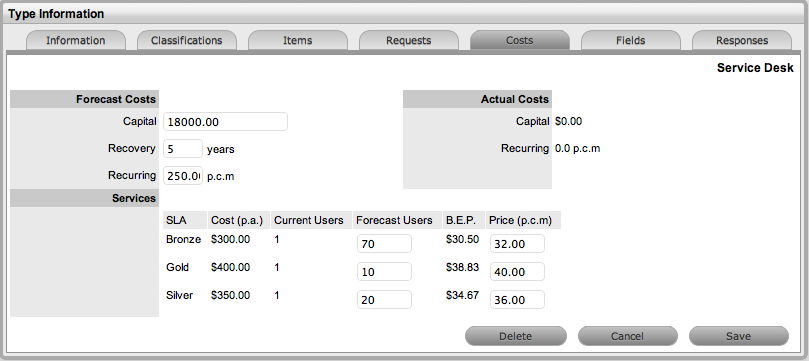
-
Click Save and Done.
The forecasted Price per User is now available within the Charges Price field on the Costs tab of the Service Item.
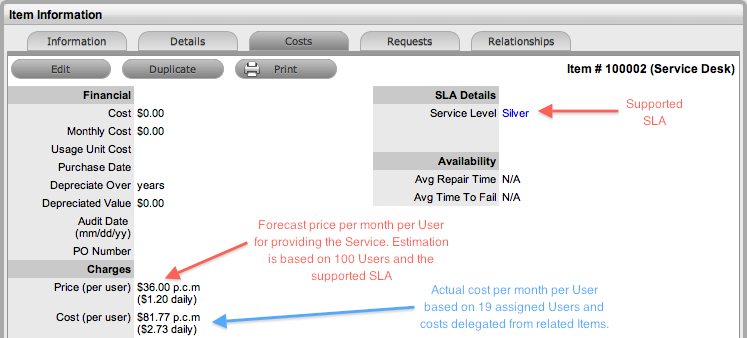
Calculate Actual Service Costs
To calculate the actual Service Costs, the relationships of the infrastructure Items that underpin the Service need to be mapped within the Relationships tab. Working with these relationships, it should be noted that the Service is considered a Child Item within the hierarchy.
To build the relationship map refer to the Relationships Tab.
After the underpinning infrastructure and its associated costs are related to the Service Item, the following financial information is available in the Service Item Costs tab:
|
Financial |
Description |
|---|---|
|
Cost |
The financial investment made to purchase the Item. This figure is also used when the Delegate Costs is enabled for allocating costs across related Items. NOTE:Typically for Service Items, the infrastructure costs would be zero as this would be derived from the associated Parent Items. |
|
Monthly Cost |
The amount invested on a monthly basis to maintain the running of an Item. This figure is also used when the Delegate Costs option is enabled for allocating costs across related Items. |
|
Usage Unit Cost |
This is used as a reference field, where the User can enter base unit cost, for example per Megabyte data charge, which can be used for calculating costs in custom reports. |
|
Purchase Date |
The date the Item was purchased. |
|
Depreciate Over |
Enter the number of years the Item is to be depreciated over, if required. |
|
Depreciated Value |
The system calculates the current value of the Item based on the Purchase Date and the number of years the Item is to be Depreciated Over. |
|
Audit Date |
Set the date the Item is next to be audited. |
|
PO Number |
If Purchase Orders are enabled for the system, the field is visible and automatically populated with the PO number generated by a User within the Finance>Purchase Orders tab, when the Item order was recorded in the system. |
|
Charges |
|
|
Price (per user) |
Draws the figure from the Service Item Type Costs tab and displays this as a daily amount. This figure is then multiplied with the number of Users/Customers assigned to the Item, to calculate the forecasted Revenue. |
|
Cost (per user) |
Draws the figure from the Inherited Costs and displays this as a daily amount. This figure is then multiplied with the number of Users/Customers assigned to the Item, to calculate the actual Costs. |
|
Revenue |
|
|
Month to Date |
Uses the Charges Price figure, multiplied by the number of Users and days of month passed, to calculate the month to date figure. |
|
Previous Month |
A reference figure for an average monthly revenue figure, based on the previous month's revenue for the Service Item. |
|
Costs |
|
|
Month to Date |
Uses the Charges Cost figure, multiplied by the number of Users and days of month passed, to calculate the month to date Cost. |
|
Previous Month |
A reference figure for an average monthly cost, based on the previous month's cost for the Service Item. |
|
Inherited Costs |
|
|
Inherited Capital |
Total infrastructure costs of parent CI's that directly contribute to the cost of the Service Item. This figure is derived from all the Cost fields within the Item Information>Costs tab of related Parent Items. |
|
Inherited Ongoing |
Running costs of all associated Items that enable the Service Item to continue to function. This figure is derived from all the Monthly Cost fields within the Item Information>Costs tab of related Parent Items. |
|
Delegate Costs |
To enable cost delegation across the relationship map allowing associated Items to inherit the costs of the current CI, select Yes. This will take the figures from the Cost and Monthly Cost fields for the Item and spread them across related Child Items. Define the technique to be used to evaluate the cost split: Child Count:Costs are split by percentage based on the number of child CI's the costs are being delegated across. User Count:Costs are split proportionally based on the number of users of the child CI's the costs are being delegated across. Custom %: Allows for the % cost to be assigned within the relationship. To do this, within the Service Item Relationships tab, all Items within the defined relationship map must have the same setting and then the Cost Split % can be set within the table included on the Relationships tab by clicking on the 0.00 link. Note, if a N/A link is visible within the Cost Split % column, then that Item does not have the Custom % option selected. |
|
Availability |
|
|
Avg Repair Time |
Entries displayed here are automatically calculated based on the average length of time an Item is offline. |
|
Avg Time To Fail |
Figures displayed here are automatically calculated based on the average time between an Item being moved to an offline State. |
Inherited Costs
Charging Organizational Units appropriately for a Service can be based on figures derived from the Items associated with the Service. For example, the Service Desk is hosted on a server and uses service management software. The costs associated with the server and software are combined to make the Inherited Capital cost, while any ongoing support contracts would be assigned as an Inherited Ongoing cost on a per month basis.
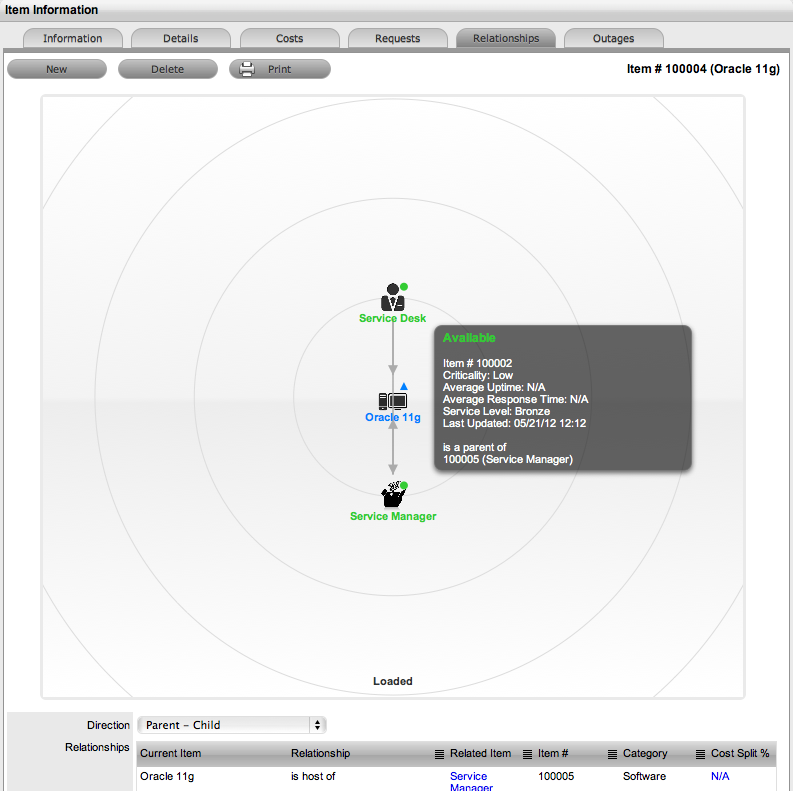
To derive the amounts from the related infrastructure and populate the fields within the Child Item, the Delegate Costs field must be enabled within the Inherited Costs for the Parent Items and the technique for deriving the cost must be assigned to the CI.
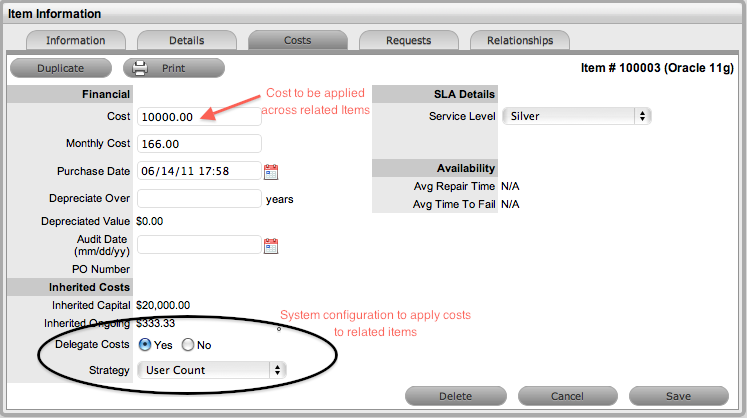
In the Service Desk example, for the server hosting the Service Desk Service it would be appropriate to delegate costs applying the Child Count technique as multiple software/service CIs may be associated with the server. While, the User Count would be used to delegate costs to the service management software.

After the relationships have been defined for the Service and the Inherited Costs applied, the Finance User can verify the forecast numbers by comparing the Inherited Costs within the Item>Costs tab, to the Capital and Recurring Costs recorded in the Item Types Costs tab. Any disparity between the figures should alert the Finance User as to whether the Service is within budget and if relevant, making or costing money.
Finance Reports
The Finance User can access the following Reports within the Reports>Finance tab, to assist with verifying the cost and revenue generated by a Service, and monitoring how a Service is used.
|
Finance Reports |
Description |
|---|---|
|
Service Cost |
The cost of providing a Service is calculated nightly and saved, along with the revenue figures, in the ITEM_REVENUE table. The cost of the Service includes all the cost factors and saves a figure each night, per service, per cost centre. This is the sum of these for a Service. |
|
Service Revenue |
The price charged for providing a Service is calculated nightly and saved, along with the cost figures in the ITEM_REVENUE table. The price charge for the Service is determined in the cost calculator configured in the Service Item Type. |
|
Total Service Cost |
The cost of providing a Service is calculated nightly and saved, along with the revenue figures, in the ITEM_REVENUE table. The cost of a Service includes all the cost factors and saves a figure each night, per service, per cost centre. This is the sum of these across all Services. |
|
Total Service Revenue |
The price charged for providing all Services is calculated nightly and saved, along with the cost figures in the ITEM_REVENUE table. The price charge for the Service is determined in the cost calculator configured in the Service Item Types associated with all Services. |
|
Service Consumption |
Uses the total number of consumers of a service as recorded in the ITEM_REVENUE table, which is broken down by cost centre, to illustrate how the number of consumers of a service varies over time. |
2.11.3 Invoices
Invoices

The Invoices sub-menu option is available within the Finance tab when the option has been enabled by the system administrator. Invoices allows support organizations to charge Customers for support services provided, and manage Items purchased with Service Contracts.
(For more information about enabling Billing, see: Setup>Billing within the Administrator Guide.)
An Invoice can be created when an Item and Service Contract is ordered by a Customer. Alternatively, Invoices can be created for Service Contracts alone, as the Item may already exist in the system.
Invoices can be generated by the system through the following screens:
-
Within the Invoices section
-
When an Incident is created against an out-of-contract Item
-
When an Item, Customer or Organizational Unit is created, or edited to assign a new SLA.
The following sections are covered within Invoices:
-
Invoice creation - creating an invoice for a Service Contract or an Item with a Service Contract
-
Invoice summary screen - Summary tabs, emailing and editing an Invoice, and information about an Invoice Status
-
Invoice payment and delivery - processing an Invoice when payment is required.
Creating Invoices
Invoices can be created for Items and associated service Contracts, and for Items or Service Contracts only.
Creating an Invoice to purchase an Item and Service Contract
To create an Invoice:
-
Select Finance>Invoices
-
Click New
The Customer tab appears.
-
To assign a Customer to the Invoice:
-
Search for a Customer who already exists in the system
Enter any known information such as their First Name, Last Name, Email Address, Org. Unit or Username in the Find Customer fields. To view a list of all Customers in the database, leave all the fields blank.
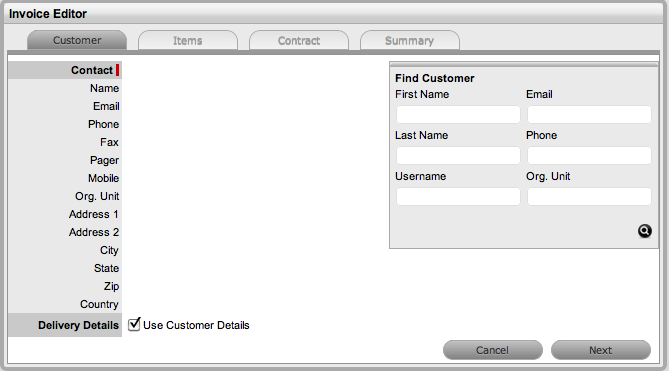
-
Click

-
Click on a Customer's name to assign them to the Invoice
The Delivery Details are automatically extracted from the Customer Details. If they are not the same, uncheck by clicking the tick in the Use Customer Details box and enter the correct details.
-
Select Next to continue.
The system moves to the Items tab.
-
-
To add an Item Type for an Item Order:
-
Select
 if the Invoice is to purchase a new Item
if the Invoice is to purchase a new Item
Otherwise, click Next to purchase a Service Contract.
-
Search for the Item Type to be associated with the Invoice
Leave the search field blank and click the Search button to display a list of Item Types that can be assigned to the Invoice
-
Select the relevant Item Type link to add it to the Invoice
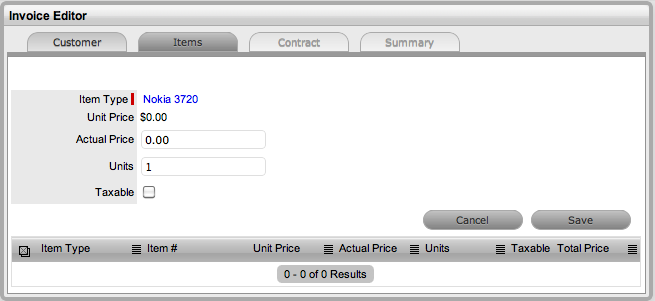
-
Enter the Actual Price information, if relevant and the number of Units to be ordered
-
Mark the order as Taxable if required
The tax is not included in the Actual Price but will be calculated within the Invoice Summary tab.
-
Click Save to add
The Item Type details are applied to the Invoice

-
To add more Item Types, select
 and repeat the above process.
and repeat the above process.
Alternatively, click Next to move to the Contract tab, if required.
-
-
To add a Service Contract for a newly ordered Item Type:
-
Select
 to add a Service Contract to the Invoice
to add a Service Contract to the Invoice
Or, click Next to go to the Invoice summary.
-
Select the appropriate SLA from the drop-down options
-
Select the Item Type related to the Service Contract
To search for an Item Type enter any known details in the Find Item Type search field.
-
Click the Item Type link to assign it to the Invoice
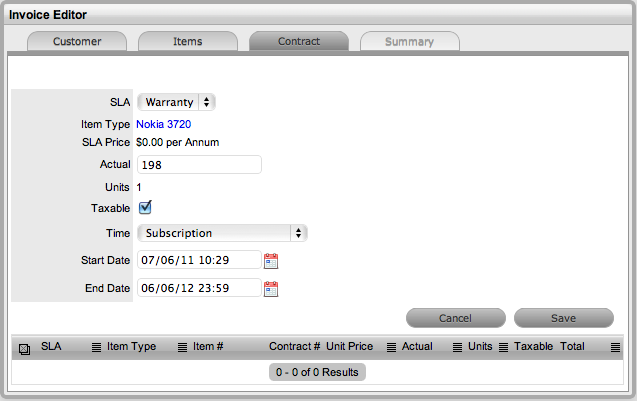
-
Amend the Actual Price, if relevant
-
Check the Contract as taxable, if relevant
-
Select the Time period covered by the Contract:
Subscription - a contract that covers a specified period of time
Time Limited Subscription - a contract that covers either a specified period of time or number of support hours, whichever limit is reached first
Support Hours - a contract that defines the number of support hours covered
Support Hours by Month - a contract that covers a total number of support hours purchased for a defined timeframe and allocated on a per month basis.
-
Click Save.
-
-
To add another contract to the Invoice, click
 and repeat the above process.
and repeat the above process.

-
Click Next to move onto the Summary page
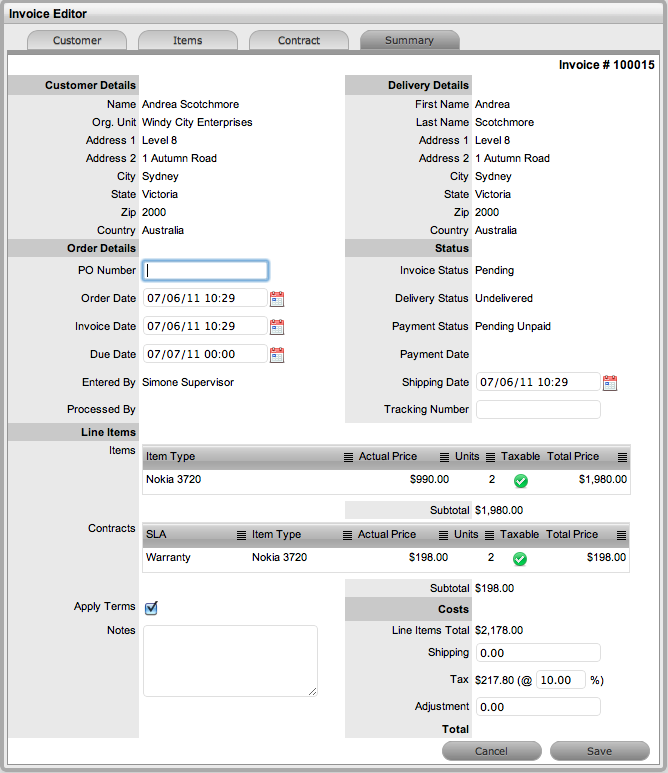
-
Enter a PO Number and make any other adjustments, if relevant
-
Click Save
-
Select
 to send the Invoice to the Customer, if required
to send the Invoice to the Customer, if required
-
Click Done.
Creating an Invoice to Purchase a Service Contract
To create a Service Contract Invoice:
-
Select Finance>Invoices
-
Click New
The Customer tab appears.
-
To assign a Customer to the Invoice:
-
To search for a Customer who already exists in the system
Enter any known information such as their First Name, Last Name, Email Address, Org. Unit or Username in the Find Customer fields. To view a list of all Customers in the database, leave all the fields blank.

-
Click

-
Click on a Customer's name to assign them to the Invoice
The Delivery Details are automatically extracted from the Customer Details. If they are not the same, uncheck by clicking the tick in the Use Customer Details box and enter the correct details.
-
Select Next
The system moves to the Items tab and displays the following message

-
Click Next again
The system moves to the Contract tab.
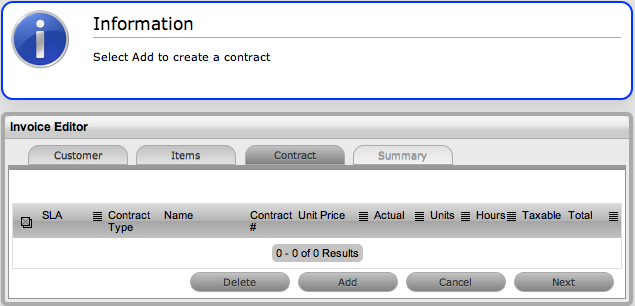
-
-
To create a Service Contract:
-
Select
 to create the Service Contract
to create the Service Contract
-
Select the appropriate SLA from the drop-down options
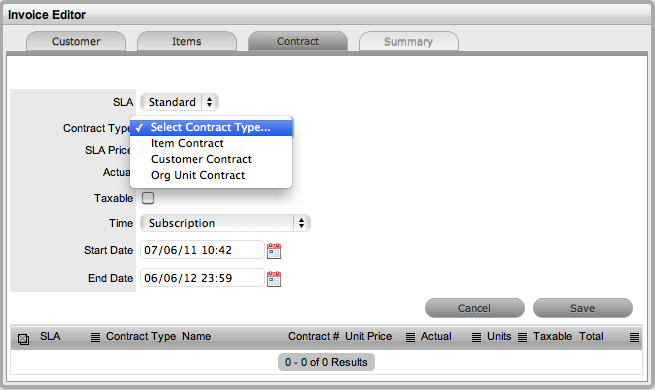
-
Select the Contract Type
Contract Type
Description
Item Contract
To purchase a contract for an Item. Search and select an Item using the Find Item search.
Customer Contract
To purchase a contract for a Customer. Search and select a Customer using the Find Customer search.
Org Unit Contract
To purchase a contract for an Organizational Unit. Search and select an Org Unit using the Find Org Unit search.
-
Amend the Actual Price, if relevant
-
Check the Contract as taxable, if relevant
-
Select the Time period covered by the Contract:
If Subscription is selected, the Start and End Dates are automatically completed by the system.
If Time Limited Subscription is selected, the Support Hours field is displayed and the number of support hours purchased by the Customer should be entered. Also, the Start Date and End Date fields should be completed manually, entering the length of time for the subscription period.
If Support Hours is selected, the number of support hours purchased by the Customers should be entered.
If Support Hours by Month is selected, a contract that covers a total number of support hours purchased for a defined timeframe and allocated on a per month basis.
(If a Contract is forward dated with a Start Date set in the future, the Pending Contract status is assigned. See Pending Contracts.)
-
Click Save
-
-
To add another contract to the Invoice, click
 and repeat the above process.
and repeat the above process.

-
Click Next to move onto the Summary page
-
Make any adjustments, as required
-
Click Save
-
Select
 to send the Invoice to the Customer, if required
to send the Invoice to the Customer, if required
-
Click Done.
Invoice Summary
The Invoice Summary tab includes the invoiced Customer, delivery and order details. It allows Users to email the Invoice to relevant parties and displays the status of the Invoice. The summary screen also allows Finance Users to process an Invoice when payment is received.
The following fields are included with the Invoice Summary tab:
|
Fields |
Description |
|---|---|
|
PO Number |
Auto-generated or manually entered order identification number. |
|
Order Date |
Auto-generated or manually adjusted order date. |
|
Invoice Date |
Auto-generated or manually adjusted date for the invoice creation. |
|
Due Date |
The date the invoice is due. Auto-generated based on the Default Invoice Due value defined by the Administrator. |
|
Entered By |
The User who created the invoice. |
|
Processed By |
The User who processed the invoice. |
|
Invoice Status |
Displays what stage of the order process the invoice is in. |
|
Delivery Status |
Details the status of delivery for items on the invoice |
|
Payment Status |
Details if the invoice has been paid |
|
Payment Date |
Date the invoice was processed for payment. |
|
Shipping Date |
Manually entered date of shipping. |
|
Tracking Number |
Reference number manually entered to track the order. |
|
Apply Terms |
For the system terms and conditions to be included in the PDF Invoice and the Invoice emailed to the Customer, tick the Apply Terms option. |
|
Notes |
Enter any additional Invoice information within the Notes field. |
|
Shipping, Discounts and Taxes |
Before saving an Invoice, any shipping costs to be included in the grand Invoice total can be entered in the Shipping field. |
|
Adjustment |
The Adjustment field records Customer discounts and will be subtracted from the final order total. |
NOTE:A flat tax percentage can be added to taxable line Items included on the Invoice. This is a global property that is configured by the system Administrator, in Setup>Billing>Tax Rate, but can be edited if required.
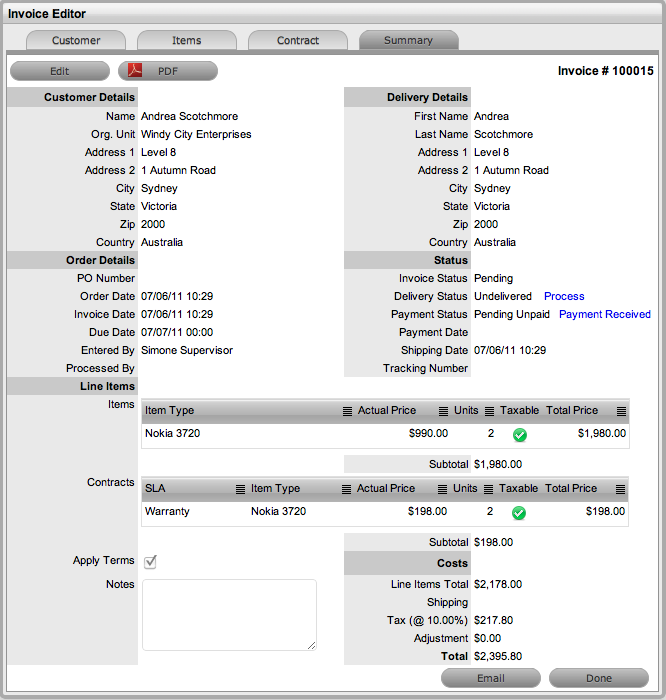
Emailing an Invoice
Once an invoice is created, selecting the Email button will send a copy of the Invoice to:
-
The Customer who placed the order
-
The system Finance User
-
The User who recorded the Invoice
-
The Customer who will take delivery, if different to the person who placed the order.
If the system Administrator has enabled the Email Invoice functionality in the application Setup, the Invoice will be emailed automatically to the relevant parties when it is created.
Invoice Status
When an Invoice is first logged in the system it has a status of Pending. A pending Invoice can be edited. However, when an Invoice has been successfully delivered or processed, the Invoice Status moves to Active and it is no longer editable.

An Invoice changes to a status of Cancelled when one of the following events occurs:
-
Another Invoice is created to supersede the original Invoice; or
-
The Invoice was created for a specific Incident and that Incident was deleted/cancelled either manually or due to the Incident Cancel Time, set by the system Administrator, being exceeded. See Setup>Billing within the Administrator Guide.
Editing an Invoice
To amend Invoice details or to include additional Line Items, edit or enter the information prior to selecting the Process hyperlink. This link is not available when the Invoice is in Edit mode, as all Invoice information must be locked down to ensure the application has control of the details of the Items and their delivery.
Invoice Payment & Delivery
Relative to the workings of your support organization, Item and/or Support Contract Invoices may or may not need to be paid before an Item can be delivered to your Customer or Support Contract used by your Customer.
To update the Shipping Date, open the Invoice in Edit mode when the Delivery Status is Undelivered and enter the relevant date within the Shipping Date field.
Processing an Invoice when Payment is Required
For organizations where the option of Payment Required is enabled by the Administrator, a User with Finance access is the only User who can update the Payment Status of an Invoice. To update the Payment Status, the Finance User selects the Payment Received hyperlink of an Invoice to change the status to Paid. Once payment has been made, any other User, such as a Supervisor, can process the Invoice.

Processing an Invoice when Payment is not Required
If the Payment Required option has not been enabled by the system Administrator, a Line Item can be activated in the support system by selecting the Delivery Status Process hyperlink. This means that Customer payment does not need to be received by the organization before the Customer Item is delivered or a support contract is activated in the system.
When the Process hyperlink is clicked, the Invoice Status is updated to Active, and the Delivery Status changes to Delivered. (If the invoice is related to a support contract, the request status is moved from Pending - No Contract to the Workflow default open State, such as Pending.)
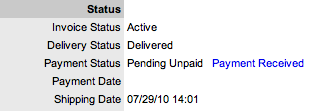
2.11.4 Purchase Orders
Purchase Orders
Purchase Orders within the system can simplify the tracking of where and when new Items are purchased or leased. This feature is not meant to replace an organization's original Purchase Order system, it is designed to easily link a specific PO number (and its associated vendor and date information) with an Item.
Select the Purchase Order sub-menu button under the Finance tab to display the list of current Purchase Orders in the system and the Purchase Order search tool.
To create a new Purchase Order:
-
Select Finance>Purchase Orders
-
Click New
The Purchase Order editor appears.
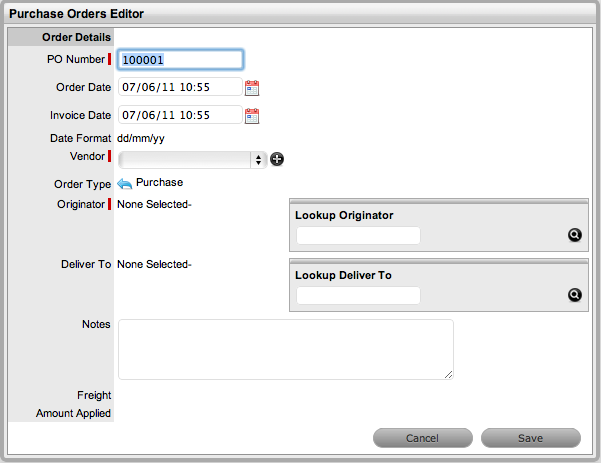
-
Enter the following details for the Purchase Order:
Field
Description
Order Details
PO Number*
The Identification number assigned to the Purchase Order (Must be unique).
Order Date*
The date the Purchase Order was entered.
Invoice Date*
The date the vendor shipped the Item. This information
is used to help calculate warranty / lease expiration date.
Vendor*
The distributor or vendor of the item. Select from the drop-down menu, or create a new entry using the
 button (at minimum for a new entry, the Vendor name is required).
button (at minimum for a new entry, the Vendor name is required).
Order Type*
Purchase or Lease. Use the icon to switch been Types. If Lease is selected, Lease Length must be defined.
Originator Name*
The Customer who placed the order. Use the last name to lookup the Customer, select the name to assign.
Deliver To
The Customer to take delivery and ownership of the new Item. Use the last name to look-up the Customer. If a Customer is not selected, it will remain as the Originator.
Notes
Additional information regarding the Purchase Order.
* Denote Mandatory Fields
-
Click Save to enter the Purchase Order into the database.
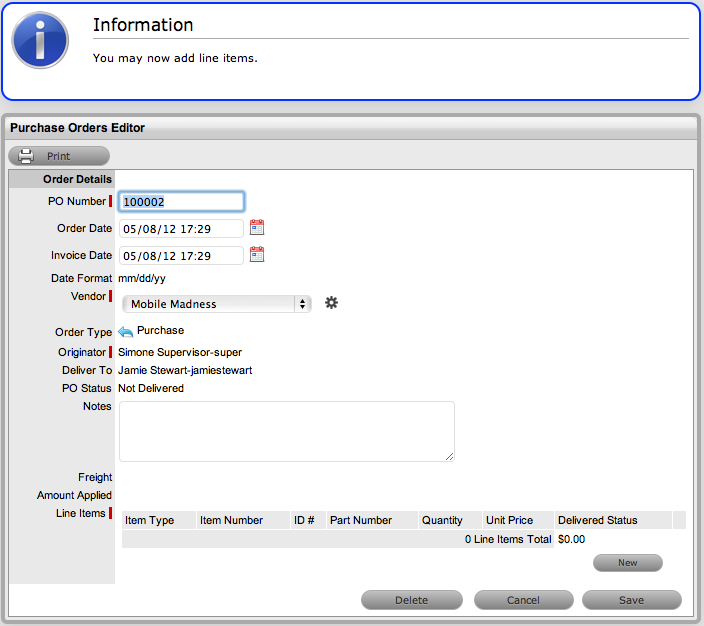
Adding Line Items
Once a Purchase Order is saved to the database, the Line Item editor becomes available at the bottom of the Purchase Order form. Line Items define the Item Type, and contain part number and price information options.
To add a new Line Item:
-
In the Line Item field, click New

-
Search and select the Item Type

-
Complete the Part Number (if known)
-
Enter the Price
-
Enter the Quantity
-
Click Save

-
To add more line items to the PO, click New and repeat steps 2 to 6
Remove any unwanted line items by selecting
 within the relevant line.
within the relevant line.
-
Click Save
The Purchase Order is moved out of edit mode.
-
Click Done.
NOTE:Purchase Orders and Invoices are not automatically linked within the system. However, Invoices can be created for Purchase Orders. See: Invoices.
Editing Existing Line Items
To edit an existing PO:
-
Select Finance>Purchase Orders
-
Click the PO Number link
-
Click Edit
-
Move to the Line Items field and click the relevant Item Type link
The screen expands the Line Item editor.

-
Make the required changes
-
Click the Save button, within the Line Items field.
Removing a Line Item
To remove a Line Item from an existing Purchase Order:
-
Select Finance>Purchase Orders
-
Click the PO Number link
-
Click Edit
The Minus and New buttons are displayed in the Line Item field.

-
Move to the Line Items field and next to the relevant Item Type click

-
The system will confirm that the User wishes to continue

-
Click OK
-
Click Save.
Converting a Purchase Order to an Item Number
A Purchase Order can be associated with an Item Number after its delivery has been recorded.
To confirm delivery:
-
Select Finance>Purchase Orders>Order number Hyperlink
-
On the Purchase Order Number link, click Edit
The Purchase Order opens in edit mode. Item information can be edited by selecting the Item Type link before Delivery has been processed.
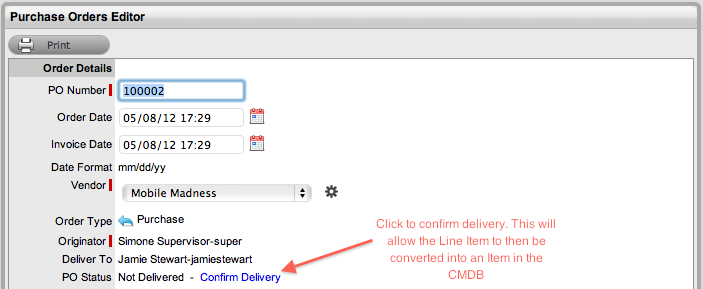
-
Click the Confirm Delivery hyperlink
The system will ask to confirm delivery.
-
Click OK within the system message
The Generate Items For Delivered Line Items link appears.

-
Click the link to generate an Item number
This will generate a new Item for each line item of the PO.

-
Click Save
The application will return to the Purchase Order screen.
-
Click Done.
Searching Purchase Orders
Existing Purchase Orders can be searched using the PO number, order date, invoice date, the person who placed the order, the person to be allocated the Item or the Vendor.
To search for a specific PO:
-
Select Finance>Purchase Orders
-
Click Search
The Search Purchase Orders screen is displayed.
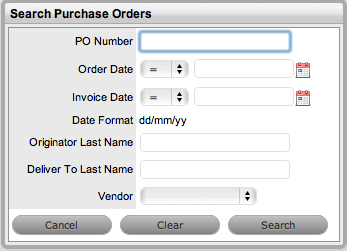
-
Enter the search details
-
Click Search
The results are displayed in a Purchase Order list. Use the column header arrows to sort the PO list.
-
Click the PO Number link to view or edit PO details.